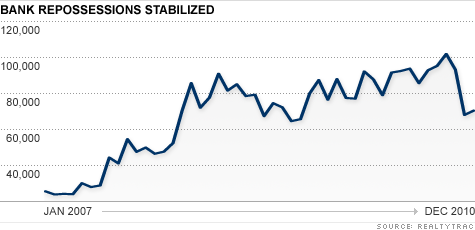Shadow inventory threatens housing recovery
 By Les Christie, staff writerJanuary 20, 2011: 7:34 AM ET
By Les Christie, staff writerJanuary 20, 2011: 7:34 AM ET
NEW YORK (CNNMoney) — There is a growing glut of foreclosed homes threatening to hit the market over the next couple of years, potentially delaying any recovery.
There were 1.7 million homes either owned by the bank or in some stage of foreclosure at the end of the third quarter of 2010, according to a recent report by Standard & Poor’s. It would take 44 months, at the current rate of sales, to sell them off — a 25% increase from the beginning of 2010. (S&P does not count home loans backed by Fannie Mae and Freddie Mac.)
This so-called “shadow inventory” may depress home values and delay the housing market recovery.
“The problem is you have all these properties coming down the pipeline that are nearly certain to hit the market. That’s going to be a negative for the supply-demand equation,” said Diane Westerback, Managing Director for S&P and an author of the report.
S&P defines shadow inventory as properties whose borrowers are (or recently were) 90 days or more delinquent on their mortgage payments, ones currently or recently in foreclosure or that are back in the hands of the banks.
Data through Sept. 30 from the Mortgage Bankers Association, which tracks about 80% of the market, suggests there are more than 2 million Americans seriously delinquent on their mortgages and another 2 million bank-owned homes. Plus, RealtyTrac reported last week that a million homes were repossessed in 2010
Westerback said the biggest contributor to the longer shadow inventory is that banks are taking far longer to foreclose on homes than they once did.
There are several reasons for that. One is that banks have struggled to keep up with the sheer volume. Last year there were nearly 2.9 million homes that received some kind of foreclosure notice.
Many foreclosures have also been delayed as banks make greater efforts to save homes by modifying mortgages. Gathering all the paperwork and working out a deal with all the parties takes time.
The banks have gotten better at this, according to S&P, with modified loans less likely to re-default. In early 2008, 80% to 85% of these loans re-defaulted. By the third quarter of 2009, that had dropped to a 50% to 55% rate.
Of the 20 separate markets S&P analyzed, Miami was the only market of the 20 that S&P analyzed where shadow inventory did not did expand during the first three quarters of 2010.
In Minneapolis, it rose 61% between Dec. 31, 2009 and Sept. 30, 2010, to 35 months from 21. Las Vegas went up 48% to 30 months supply, and Portland, Ore. jumped 47% to 45 months.
In New York, foreclosures are relatively moderate, but many have gotten stuck in the pipeline. As a result, the state now has the longest shadow inventory list, with nearly 10 years worth of homes. Boston’s shadow inventory is at 62 months and Miami’s is 60. ![]()
Tags: Foreclosures, indicators, real estate, trends, US Real Estate
 Oxstones Investment Club™
Oxstones Investment Club™